 |
 |
 |
 |
 |
 |
 |
 |
 |
 |
 |
 |
 |
 |
 |
 |
 |
 |
 |
 |
 |
 |
 |
 |
 |
 |
 |
 |
 |
 |
 |
 |
 |
 |
 |
 |
 |
 |
 |
 |
 |
 |
 |
 |
 |
 |
|
|
 |
|
|
|
SOUTHEASTERN CARIBBEAN BIRDS
PHOTO GALLERY |
|
|
|
 |
|
|
|
Trinidad and Tobago Field Naturalists' Club Southeastern Caribbean Bird Alert Trinidad and Tobago Rare Bird Committee
|
|
|
|
IDENTIFICATION ESSAY |
|
|
|
Caribbean Martin and Gray-breasted Martin (Progne dominicensis and P. chalybea) |
|
|
|
The Caribbean Martin breeds in the Greater Antilles
(except Cuba), Lesser Antilles and Tobago, and is thought to migrate to
South America from October to December. It is a regular migrant in
Curacao and Bonaire, occurring only during fall and spring, suggesting
that it passes through these islands while migrating between the
Greater Antilles and South America. Small numbers are known to winter
in Barbados. Vagrants have been reported from the southern Bahamas,
Cayman Islands and Trinidad. Although there are unsubstantiated sight
records from Guyana, there appear to be no further records from South
America, where it may be expected to occur during winter.
The Gray-breasted Martin breeds throughout Central and South America,
with northernmost populations migrating southward during the boreal
winter and southernmost populations migrating northward during the
austral winter.
In the southeastern
Caribbean, the Caribbean Martin breeds in Tobago whereas the
Gray-breasted Martin breeds in Trinidad. There are at least four
records of adult male Caribbean Martins in Trinidad (click here)
plus a few reports of possible hybrids, and one unsubstantiated sight
record of a Gray-breasted Martin in Tobago. The identification of these
two species was discussed by Ridgely and Tudor (1989) and Hill (2002),
and is further discussed in this photo essay.
Juveniles.--Juveniles
resemble adults but are smaller. Recently fledged juveniles possess a
yellow edge to the bill which quickly darkens with age. Juvenile
Caribbean Martins closely resemble adult females, which are browner
than adult males. Because juvenile Caribbean Martins are smaller, they
could easily be mistaken for a Gray-breasted Martin or even a
Brown-chested Martin (P. tapera).
The dark chest and flanks of juvenile Caribbean Martin is more uniform
in colour and contrasts more strongly with the white underparts than in
a juvenile Gray-breasted Martin.
Adult males.--Adult
males are diagnostic. Both species are glossy bluish-black above. In
Caribbean Martin the bluish-black chest and flanks contrast sharply
with the white belly and undertail coverts. In Gray-breasted Martin the
dark greyish chest grades gradually to white on the belly and undertail
coverts, which do not contrast with the flanks.
Adult females.--Adult
females tend to have paler upperparts than males. Females of the two
species are very similar. In Caribbean Martin the greyish-brown chest
extends downward on the flanks, although not as extensively in the
male, and contrasts sharply with the white belly and undertail coverts.
The border between the dark breast and white belly tends to be pointed
in the centre of the breast. In Gray-breasted Martin, the dark
greyish-brown chest grades more gradually to white on the belly and
undertail coverts without a distinct pointed appearance, and the flanks
do not contrast with the belly.
LITERATURE CITED
Hill, J. R., III. 2002. A guide to sexing and aging Purple Martins. Birding 34:244-257.
Ridgely, R. S., and G. Tudor. 1989. The birds of South America. Vol. 1. The oscine passerines. University of
Texas Press, Austin, TX. |
|
|
|
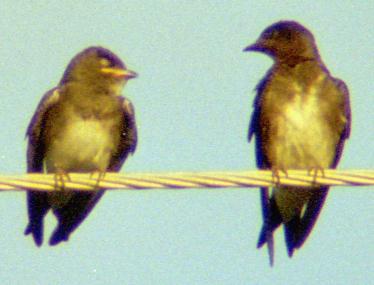 |
|
|
|
Fig.
1. Juvenile (left) and adult female (right) Caribbean Martins at Bon
Accord, Tobago, 7 August 2002. Photo © by Floyd Hayes. Note the smaller
body size and yellow edges to the bill of the juvenile. Other than the
whitish throat of the juvenile, the extent of dusky colouration on the
underparts appears similar. |
|
|
|
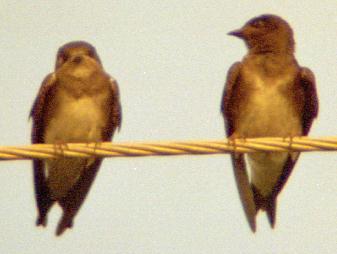 |
|
|
|
Fig.
2. Juvenile (left) and adult female (right) Caribbean Martins at Bon
Accord, Tobago, 7 August 2002. Photo © by Floyd Hayes. These are the
same birds illustrated in Fig. 1, but note the pale throat of the
juvenile which gives a breast-band effect similar to that of a
Brown-chested Martin. |
|
|
|
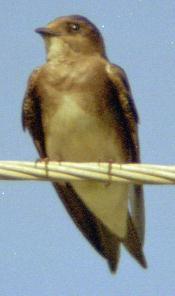 |
|
|
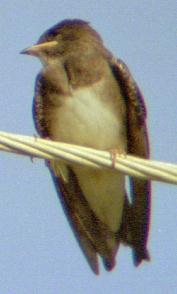 |
|
|
|
|
Fig.
3. Juvenile Caribbean Martin at Bon Accord, Tobago, 8 August 2002.
Photo © by Floyd Hayes. Again note the yellowish edges of the bill and
whitish throat. |
|
Fig.
4. Adult female Caribbean Martin at Buccoo, Tobago, 8 August 2002.
Photo © by Floyd Hayes. Note the pale throat of this individual, giving
the appearance of brown breast band.. |
|
|
|
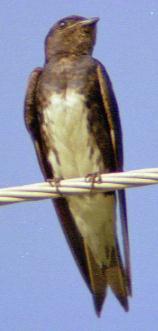 |
|
|
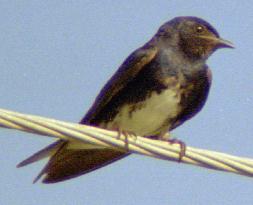 |
|
|
|
|
Fig.
5. Adult male Caribbean Martin at Bon Accord, Tobago, 8 August 2002.
Photo © by Floyd Hayes. Note the bluish-black breast and flanks
contrasting sharply with the white belly. |
|
Fig. 6. Adult male Caribbean Martin at Buccoo, Tobago, 8 August 2002. Photo © by Brett Hayes. |
|
|
|
|
|
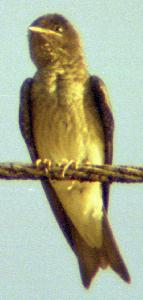 |
|
|
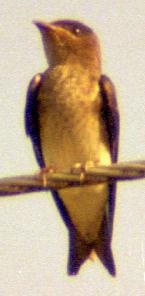 |
|
|
|
|
Figs.
7 and 8. Gray-breasted Martins of uncertain age and sex at Grande
Riviere, Trinidad, 17 August 2002. Photos © by Floyd Hayes. Although no
juveniles were noted in the flock of c. 20 birds, the pale sides of the
bill suggest that these birds may be juveniles, but aolternatively may
represent reflection of strong sunlight. |
|
|
|
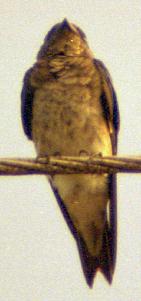 |
|
|
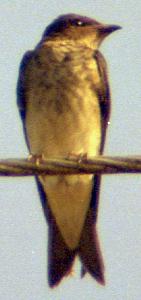 |
|
|
|
|
|
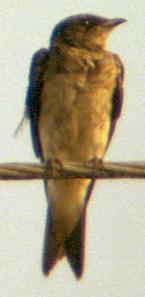 |
|
|
|
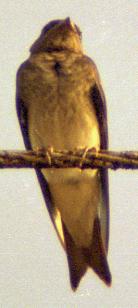 |
|
|
|
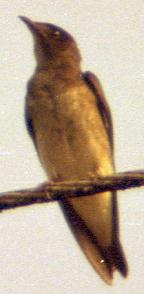 |
|
|
|
Figs.
9-13. Gray-breasted Martins of undetermined age and sex at Grande
Riviere, Trinidad, 17 August 2002. Photos © by Floyd Hayes. Due to the
lighting conditions these birds appear browner than normal. Note the
gradual gradation from a dark chest to the whitish belly and undertail
coverts, with no contrasting dark flanks. |
|
|
|
 |
|












